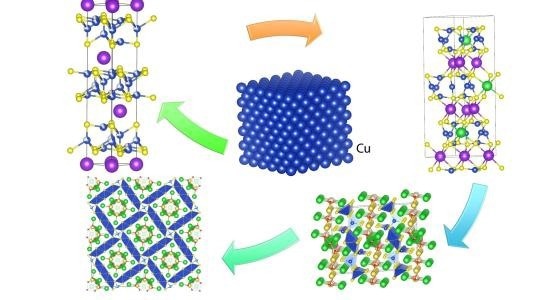The most talented artists in the world can use a few different paints to produce a unique canvas fit for a museum. They accomplish this by drawing on inspiration, historical knowledge, and design principles they have absorbed through years of studio work.
 Reaction pathway from simple precursor to complex structure. Final product here is a layered structure with five elements—sodium, barium, oxygen, copper, and sulfur. Image Credit: Argonne National Laboratory
Reaction pathway from simple precursor to complex structure. Final product here is a layered structure with five elements—sodium, barium, oxygen, copper, and sulfur. Image Credit: Argonne National Laboratory
Similar processes are being used by chemists when creating new compounds. An innovative technique for finding and creating new crystalline materials with two or more elements has been developed by researchers at the University of Chicago, Northwestern University, and the Argonne National Laboratory of the US Department of Energy (DOE).
We expect that our work will prove extremely valuable to the chemistry, materials, and condensed matter communities for synthesizing new and currently unpredictable materials with exotic properties.
Mercouri Kanatzidis, Professor, Department of Chemistry, Northwestern University
Xiuquan Zhou, study first author and a postdoctoral researcher at Argonne, stated, “Our invention method grew out of research on unconventional superconductors. These are solids with two or more elements, at least one of which is not a metal. And they cease to resist the passage of electricity at different temperatures—anywhere from colder than outer space to that in my office.”
Over the last 50 years, researchers have found and created a large number of unusual superconductors with intriguing magnetic and electrical properties. These materials have a wide range of potential applications, including enhanced energy transmission, power generation, and high-speed transportation.
Future quantum computers, magnetic resonance imaging devices, particle accelerators, and energy-efficient microelectronics could also make use of them.
The team’s process for invention begins with a two-part solution. One works as a powerful solvent. Any solids that are added to the solution cause it to dissolve and react. The other does not work as effectively as a solvent.
However, it is there to adjust the reaction so that when new elements are added, a new solid is produced. Changing the temperature and the ratio of the two components is part of this tuning. Here, the temperature is quite high, from 750 to 1,300 degrees Fahrenheit.
Kanatzidis noted, “We are not concerned with making known materials better but with discovering materials no one knew about or theorists imagined even existed. With this method, we can avoid reaction pathways to known materials and follow new paths into the unknown and unpredicted.”
The researchers tested their approach on crystalline compounds made of three to five elements as a test case. Their discovery process produced 30 previously undiscovered compounds, as was recently reported in Nature. Ten of them have unheard-of architectural designs.
At the X-Ray Science Division’s 17-BM-B of the Advanced Photon Source, a DOE Office of Science user facility at Argonne, and the UChicago ChemMatCARS beamline at 15-ID-D, the team prepared single crystals of some of these novel compounds and characterized their structures.
With beamline 17-BM-B of the APS, we were able to track the evolution of the structures for the different chemical phases that formed during the reaction process.
Wenqian Xu, Beamline Scientist, Argonne National Laboratory
Zhou added, “Traditionally, chemists have invented and made new materials relying only on knowledge of the starting ingredients and final product. The APS data allowed us to also take into account the intermediate products that form during a reaction.”
The project benefited from important experimental data and theoretical calculations provided by the Center for Nanoscale Materials, a DOE Office of Science user facility at Argonne.
Given that the technique can be used with virtually any crystalline solid, this is only the beginning of what is possible. It can also be used to create a variety of crystal structures. That includes multiple stacked layers, a single layer an atom thick, and chains of molecules that are not linked.
Such unusual structures have unique properties that are essential for creating next-generation materials that can be used for microelectronics, batteries, magnets, and other applications in addition to superconductors.
The Basic Energy Sciences program of the DOE’s Office of Science provided funding for this study.
Journal Reference:
Zhou, X., et al. (2022) Discovery of chalcogenides structures and compositions using mixed fluxes. Nature. doi:10.1038/s41586-022-05307-7.